The Jicama Superfood
Jicama is a root vegetable that is native to Mexico and South America. It has a crunchy texture, and slightly sweet taste, and is often used in salads or as a healthy snack due to its low-calorie count. Jicama has been gaining popularity as a superfood in recent years because of its high nutritional value. But the question remains: can dogs eat jicama too?

Canine Taste Buds
Before we dive into the question at hand, let’s talk about canine taste buds. Dogs have about 1,700 taste buds compared to humans’ 9,000.
This means that their sense of taste is not as developed as ours. They are not as sensitive to flavors. This also means that dogs are less likely to enjoy certain foods such as jicama that do not have strong flavors.
Is Jicama Safe for Dogs?
The good news is that jicama is generally safe for dogs to eat in moderation. However, there are some precautions you should take before feeding it to your furry friend.
Firstly, jicama should always be served in small amounts. It contains high levels of fiber which can cause digestive issues if given in large quantities. Additionally, it should always be cooked or steamed before serving because raw jicama may be difficult for dogs to digest.
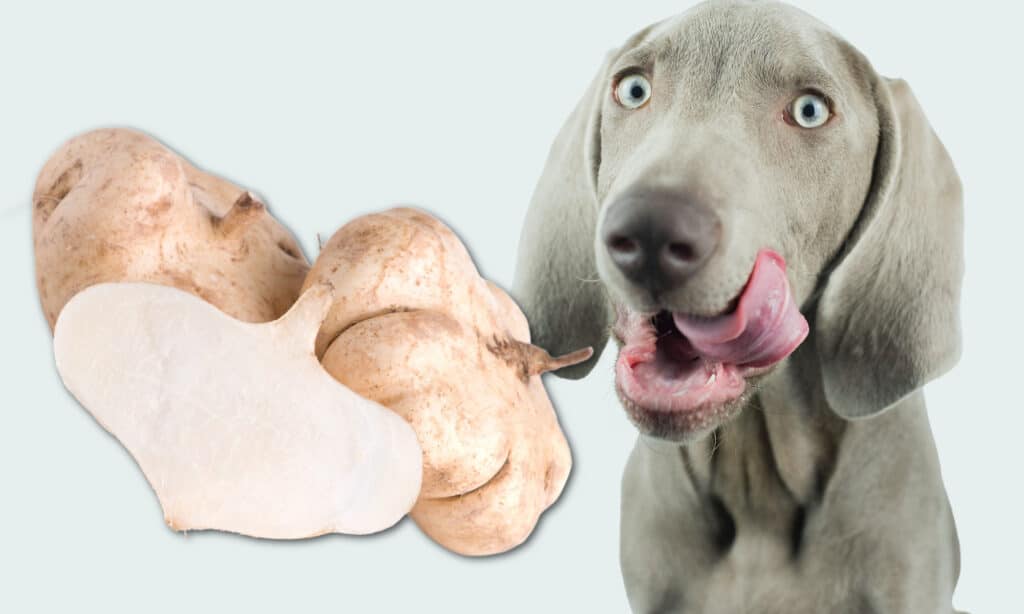
The Benefits of Jicama for Dogs
Jicama is packed with nutrients such as vitamins C and E which can help boost your dog’s immune system function. It also contains dietary fiber which promotes healthy digestion. It also helps with weight management by making your dog feel fuller for longer periods of time. Additionally, jicama can be a great alternative snack option for dogs who suffer from food allergies or intolerances since it does not contain common allergens such as wheat or dairy.
Potential Risks of Feeding Jicama to Dogs
While jicama is generally safe for dogs to eat in moderation, there are still some potential risks to be aware of. As mentioned earlier, raw jicama can be difficult for dogs to digest and may cause digestive issues such as bloating or diarrhea. Another concern is the risk of choking if your dog does not chew the jicama well enough.
To avoid this, it is best to cut the jicama into small pieces or shred it before serving. While dogs can eat jicama in moderation, you should always exercise caution and start with small amounts.
Cooked or steamed jicama is easier for dogs to digest than raw and can offer some great health benefits such as boosting their immune system function and promoting healthy digestion. As with any new food, it’s important to monitor your dog’s reaction and consult with your veterinarian if you have any concerns.

What is Jicama?
Jicama, also known as Mexican turnip or yam bean, is a root vegetable that originated in Central and South America. It belongs to the legume family and is related to beans and peas.
The plant itself can grow up to 20 feet tall and produces a large, edible tuberous root. The jicama root has a tan-colored exterior with a similar texture to that of a potato but with a slightly sweet taste.
The interior of the vegetable is white and juicy, similar to that of an apple or pear. The root can range in size from small (around the size of an avocado) to large (up to 6 pounds).
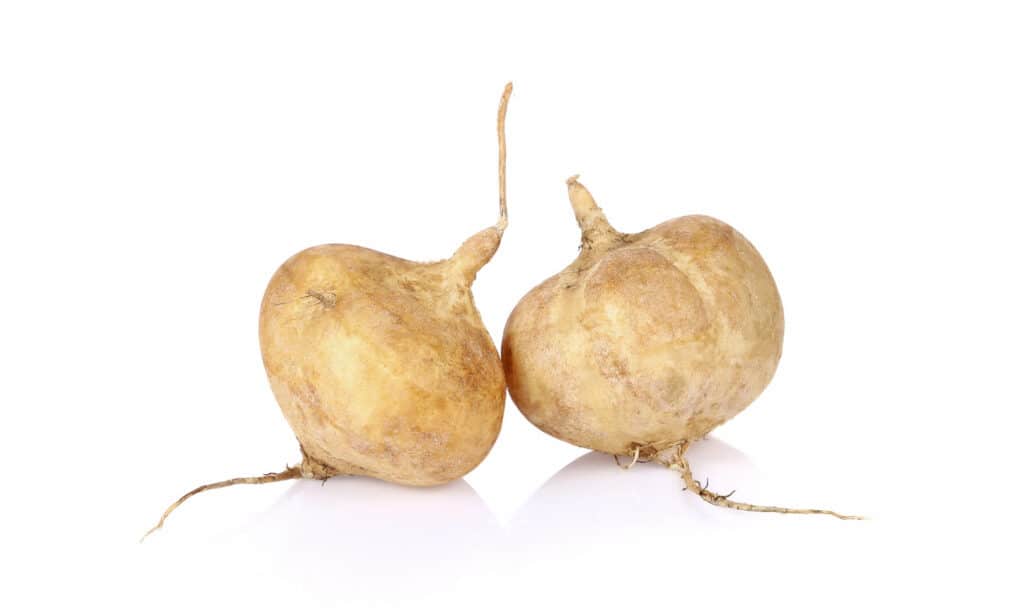
Definition and Description of Jicama
Jicama is often described as a low-starch vegetable due to its high water content. It has been used for centuries in traditional medicine as it contains many nutrients that have numerous health benefits. In terms of appearance, jicama has thin brown skin that must be peeled before consuming the crisp white flesh inside.
Some describe it as having an earthy yet slightly sweet flavor profile, though it mostly takes on whatever flavors it’s paired with. Jicama can be eaten raw or cooked and is often used in salads, slaws, stir-fries or roasted dishes.
Nutritional Value of Jicama for Humans
Jicama is considered one of the healthiest vegetables around due to its high levels of fiber and vitamin C. A cup of sliced raw jicama contains only about 50 calories but provides almost 7 grams of dietary fiber – over one-quarter your daily needs! It’s also rich in vitamin E which helps keep your skin healthy while supporting immune function thanks to its antioxidant properties. Additionally, jicama has potassium which helps regulate blood pressure by balancing out sodium levels in the body.
Jicama is an excellent source of prebiotic fiber which feeds the good bacteria in our gut, promoting overall digestive health. While jicama is a great addition to a human’s diet, we need to ask if it’s safe for dogs to eat it too.

Can Dogs Eat Jicama?
Jicama is a popular vegetable among humans due to its crunchy texture and sweet taste. But can dogs eat jicama too? The answer is yes, dogs can safely consume jicama in moderation.
It is a healthy, low-calorie snack that can offer nutritional benefits to your furry friend. However, it is important to note that not all dogs will react the same way to jicama.
Some dogs may have difficulty digesting it due to its high fiber content, while others may experience an upset stomach or diarrhea if they consume too much. It is always best to introduce new foods slowly and in small amounts to monitor your dog’s reaction.
Is Jicama Safe for Dogs?
Jicama itself is not toxic or harmful to dogs, but there are some potential risks associated with feeding it to them. As mentioned above, the high fiber content of jicama can cause digestive issues for some dogs. It is also important to note that the skin and seeds of the jicama plant are not safe for consumption by either humans or animals.
In addition, jicama should never be a substitute for a balanced diet specifically formulated for your dog’s needs. While it does contain beneficial nutrients such as vitamin C and E and potassium, it should only be given as an occasional treat.
The Benefits of Jicama for Dogs
When fed in moderation as part of a well-balanced diet, jicama can offer numerous health benefits for your furry friend. Firstly, it is low in calories and high in fiber which makes it an excellent snack option if you’re looking to help manage their weight.
Jicama also contains vitamin C which supports immune system function and promotes healthy skin and coat. Additionally, vitamin E found in jicama has antioxidant properties that protect against cell damage and promote healthy aging.

The Risks of Jicama for Dogs
While jicama has many benefits, there are also some risks to consider before feeding it to your dog. As mentioned above, the high fiber content can cause digestive issues in some dogs.
It is also important to note that jicama should only be given in small amounts and cut into small pieces or shredded to avoid the risk of choking. If you notice any adverse reactions such as vomiting, diarrhea, or lethargy after feeding your dog jicama, it’s important to contact your veterinarian right away.
How to Feed Jicama to Your Dog
If you decide to feed your dog jicama, there are a few things you should keep in mind. Firstly, it’s important to wash and peel the jicama thoroughly before serving. Next, cut it into small pieces or shred it so that your dog can easily digest it.
It’s best to start with a small amount of jicama and monitor their reaction over time. If they tolerate it well and enjoy the flavor, you can gradually increase the amount you give them.
However, as mentioned earlier in this article, remember that moderation is key when feeding any new food item to your dog. While there are some potential risks associated with feeding dogs jicama due to its high fiber content and choking hazard if not prepared properly – when given in moderation as part of a balanced diet – this vegetable can offer numerous health benefits for our furry friends.
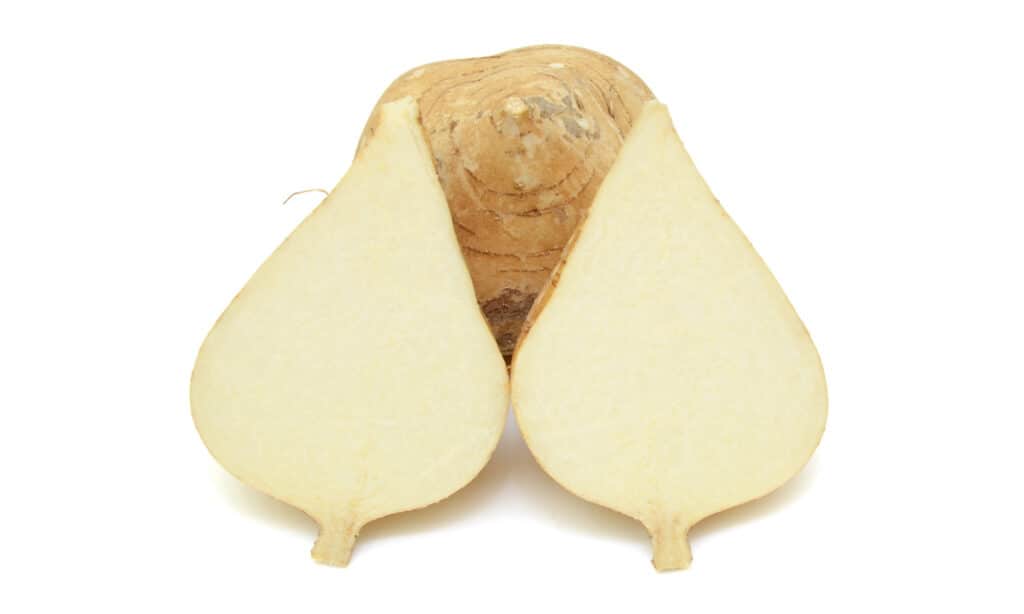
The Benefits of Jicama for Dogs
Jicama is High in Fiber
Jicama is a great source of dietary fiber, which helps to promote healthy digestion in dogs. Fiber helps to keep things moving through the digestive tract and can prevent constipation and other gastrointestinal issues. This root vegetable is also low in fat, which makes it a great option for dogs who need to lose weight or maintain a healthy weight.
Jicama is Low in Calories
Another benefit of jicama for dogs is that it’s low in calories. This means that you can feed your dog larger portions of jicama without worrying about them consuming too many calories. In fact, jicama contains fewer calories per serving than many other fruits and vegetables.
Jicama is Rich in Vitamins C and E
Jicama is also rich in vitamins C and E, which are both important nutrients for dogs. Vitamin C helps to boost the immune system, while vitamin E acts as an antioxidant that helps to protect cells from damage caused by free radicals. These vitamins play important roles in promoting overall health and wellbeing in dogs.
Jicama Can Promote Healthy Digestion
As mentioned earlier, jicama’s high fiber content makes it great for promoting healthy digestion in dogs. The fiber found in this root vegetable can help regulate bowel movements and prevent digestive issues such as constipation or diarrhea. Additionally, the high water content found within jicama can help keep your dog hydrated while aiding digestion.

Jicama Can Aid Weight Management
If your dog needs to lose weight or maintain a healthy weight, incorporating jicama into their diet may be helpful. As previously stated, this vegetable contains relatively few calories yet high amounts of dietary fiber—both essential components for any dog’s weight management plan. The fiber can help your dog feel fuller for longer while the low-calorie content keeps their overall caloric intake within a healthy range.
Jicama Can Boost Immune System Function
The high levels of vitamin C found in jicama can help to boost your dog’s immune system. Vitamin C is an antioxidant that helps to protect cells from damage caused by free radicals and provides essential support to the immune system.
Incorporating jicama into your dog’s diet can provide a natural source of this important nutrient. Jicama is not only safe for dogs to consume but also provides many health benefits.
Thanks to its high fiber, low calorie and vitamin content, it can promote healthy digestion, weight management, immune system function, among other benefits. However, as with any new food or treat you introduce into your dog’s diet, it is always best to introduce it gradually and monitor their reaction to ensure they digest it well without having any adverse reactions or allergies.
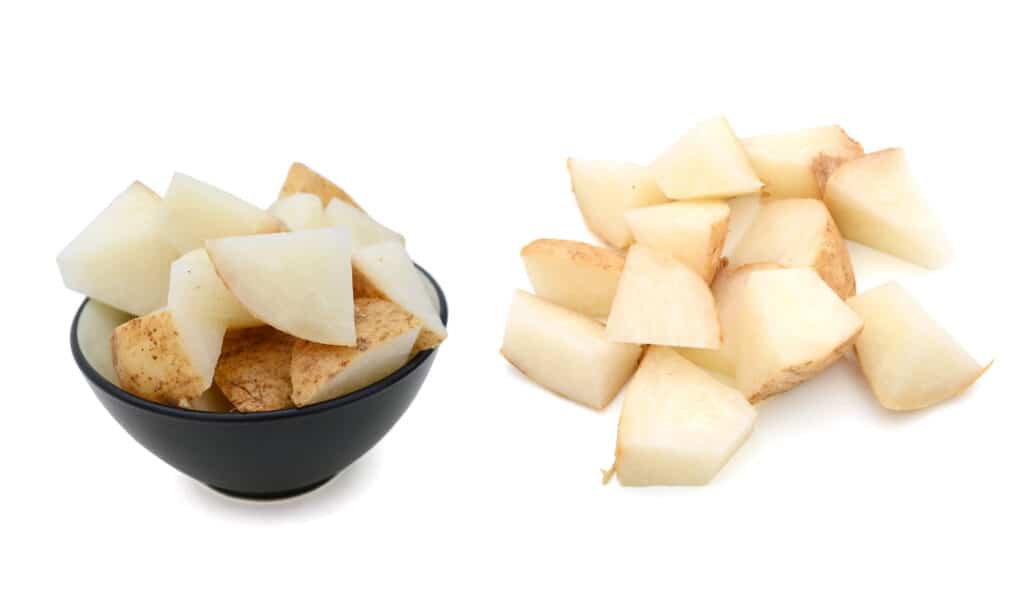
Risks of Jicama for Dogs
Difficulty digesting due to high fiber content
While jicama is packed with fiber, which is essential for maintaining good digestive health in dogs, too much of it can cause digestive problems. If your dog eats too much jicama, they may experience diarrhea or constipation. This can be especially problematic for dogs with sensitive stomachs or those prone to gastrointestinal issues.
Dogs that are new to eating jicama should start slow and gradually introduce this nutritious vegetable into their diet. This will allow their digestive system to adjust and get used to the high fiber content.
Potential choking hazard if not cut into small pieces
Jicama has a crunchy texture that many dogs enjoy. However, this texture can also make it a potential choking hazard if not prepared properly. Dogs who are enthusiastic eaters may try to swallow large chunks of jicama without chewing it properly.
To avoid the risk of choking, always cut up jicama into small pieces before feeding it to your dog. Additionally, you should always supervise your dog while they are eating and take away any large pieces that they may attempt to swallow whole.

Pre-existing Medical Conditions
Dogs with pre-existing medical conditions may be more susceptible to developing complications from consuming certain foods like jicama. For example, diabetic dogs need careful monitoring of their sugar intake so you need to make sure that you limit their intake of sweet vegetables like jicama.
Dogs with kidney disease should also avoid high potassium foods like jicama as the excess potassium can worsen the condition. It’s important you talk with your veterinarian about any pre-existing medical conditions your dog might have before introducing them to new foods, including Jicam
Allergies and Intolerances
Dogs can develop allergies to any food, and jicama is no exception. While jicama itself is not considered an allergenic food, dogs that are already predisposed to certain allergies may have a reaction if they consume jicama.
Additionally, some dogs may be intolerant to certain carbohydrates found in jicama, which can lead to digestive issues like bloating or gas. If you notice any signs of an allergic reaction or intolerance after feeding your dog jicama, stop giving it to them and consult your veterinarian.
While many dogs can safely enjoy jicama as a healthy addition to their diet, there are potential risks associated with feeding this vegetable to your furry friend. By being aware of these risks and taking the necessary precautions when offering Jicama as a treat for your dog such as cutting it into small pieces or gradually introducing it into their diet will help you alleviate any health concerns related to feeding Jicama.
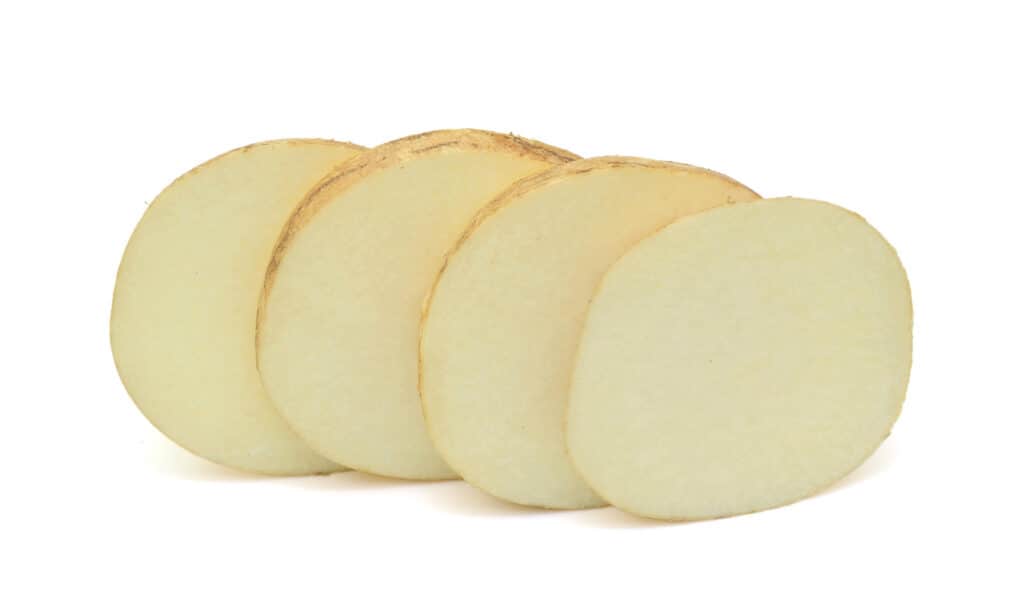
How to Feed Jicama to Your Dog
Tips on How to Safely Incorporate Jicama into Your Dog’s Diet
Jicama is a safe and healthy addition to your dog’s diet, but it’s important to introduce it slowly and in moderation. Just like humans, dogs can have different reactions to certain foods, so it’s essential to monitor their response when introducing new foods. Start by offering small amounts of jicama mixed with your dog’s regular food.
Start with Small Amounts and Monitor Their Reaction
It’s recommended that you start with a small amount of jicama for your dog – about one or two slices per day. Observe your dog for any adverse reactions such as vomiting, diarrhea or stomach upset.
If there are no signs of discomfort, you can gradually increase the amount over time. However, if you notice any negative symptoms after feeding jicama to your furry friend, stop giving them immediately.
Cut into Small Pieces or Shred Before Serving
To make sure that your dog can safely eat jicama without choking, cut it into small pieces or shred it before serving. It is best not to serve large chunks as this could lead to choking hazards or digestive problems for your furry friend.
Small pieces will be easier for them to chew and digest. When cutting jicama into smaller sizes for dogs, ensure that they are not too tiny that they pose a choking hazard for them since this could cause respiratory distress in the worst-case scenario.

Serving Methods
There are several ways in which you can serve jicama as a snack or treat for your dog. You may decide to peel off the skin entirely before cutting it up into bite-sized pieces; this makes digestion easier since dogs tend not always able to digest some skins.
Alternatively, you may leave the skin on and slice it up into thin rounds or sticks. You may also decide to mix jicama with other dog-safe fruits and vegetables such as apples, carrots, or sweet potatoes to create a healthy snack mix that your dog will love.
Make sure that you do not introduce any new foods too fast since this could cause stomach upset. Dogs can eat jicama safely if it is introduced in moderation and cut up into small pieces.
Jicama is an excellent source of vitamins C and E, fiber, and low in calories making it a perfect addition to your dog’s diet. Always monitor your pet’s reaction when introducing new foods since they can have different reactions to certain foods just like humans.
~Lindsie
